Kung Fu Hustle
 for sequences of strong stylized action and violence.
for sequences of strong stylized action and violence.
Reviewed by: Michael Karounos
CONTRIBUTOR
| Moral Rating: | Offensive |
| Moviemaking Quality: |
|
| Primary Audience: | Adults |
| Genre: | Foreign Action Adventure Comedy |
| Length: | 1 hr. 35 min. |
| Year of Release: | 2005 |
| USA Release: |
April 22, 2005 |
| Featuring | Stephen Chow, Chan Kwok Kwok Kwan, Yuen Wah, Yuen Qiu, Huang Sheng Yi |
| Director |
Stephen Chow |
| Producer | Stephen Chow, Chui Po Chu, Jeff Lau |
| Distributor |
 Sony Pictures Classics, a division of Sony Pictures Entertainment |
“Kung Fu Hustle is a complex movie that is brilliant for all the reasons reviewers have cited and for more beyond those. The film satirizes martial arts movies, cartoons, superhero movies, westerns, and American musicals. It’s a melange of not only genres, but also of themes. Kung Fu is purely pagan on one level, but it is also deeply spiritual, a fact that every single reviewer seems to have missed. Ultimately, “Kung Fu Hustle” is shockingly conservative: it favors faith, marriage, and a strong work ethic. At the same time, the movie does have cultural moments that are liberal, such as the repeated sight gag of an enormous bra, an over the top gay character, and the repeated shots of a young man’s bare behind.
To be clear, “Kung Fu Hustle” is not appropriate for Christians who are sensitive to violence or partial nudity. The film’s opening sends conflicting tonal signals, because the violence is comic and simultaneously disturbing. This causes confusion in a Christian observer as to how to interpret the film’s attitude toward its mayhem: does it revel in moral degradation like a Tarantino film, or does it suspend its ironic approval well before the brink like the “Lethal Weapon” series? The answer is somewhere in between. Christians who are accustomed to violence in film will not find anything in this movie that is particularly offensive, but it is not for children.
The repeated shots of the young man’s bare butt are objectionable, but the shots are not sexual so much as they are revealing. Since the movie is a satire, and since it satirizes numerous American cultural motifs, it is easy to conclude that Chow—the movie’s writer, director, and star—inserts a ridiculous example of nudity into the movie so that we understand he is making a point. Chow is satirizing what he sees as the disgusting practice of hip-hop and rap fans wearing their pants below their butts. What if they weren’t wearing underwear? He seems to be asking. Then you would see their butts. Satire is exaggeration, so Chow, the director, shows the young man’s bare butt in close-up, and Chow’s character, Sing, looks at it disapprovingly.
Why? Because the character is a wannabe Kung Fu fighter who tries to act tough and cool, but gets slapped around by the bad guys and knocked out by the landlady. His nudity is a metaphor: he is an ass. Chow shows his audience that a fool cannot understand that it is hard work that achieves excellence and not how one dresses (or undresses).
The film isn’t driven by plot as much as it is by character. The setting is 1940s China, in a town in which gangsters rule the police and all commerce, excepting only the poorest neighborhood in town, the tenement on Pigsty Alley. When a wannabe gangster named Sing (Chow) tries to hustle an extortion racket, he causes a melee between the brutal Axe gang and the cook, the tailor, and the laborer in the tenement. The allegory-heavy conflict is between people who work for a living and the parasitic gangsters who live off criminal activity. The idea of working for a living is important in the movie and reflects a conservative Chinese ethic that has deep, Confucian roots. The workers win, but it is a Pyrrhic victory, since their victory invites greater retribution.
Chow’s character is shown in two defining moments as a young boy. In the first, a street person cons him into buying a two cent tract with the ten dollars he was saving to become a doctor or a lawyer. There are two ideas embedded in this action. First, he sacrifices his dream of honorable work for a scheme to become famous. Secondly, he pays dearly for something that is nearly free, the Christian equivalent of paying for grace with the currency of works. The tract purports to teach the Buddhist Palm Move Method, a martial arts style of fighting. His first attempt to use it in defense of a mute girl causes him to be beaten and humiliated. Utterly shamed, he discards the tract, shuns the girl’s attempts to comfort him, and runs off to a future life of petty crime and cowardice. In so doing, he forfeits his honorable dream to become a useful social figure, and he forfeits any possibility of using the tract’s expression of faith in an appropriate manner.
The movie’s satire of genres includes self-conscious references to Spiderman (“With great power comes great responsibility”), to Batman (a fireworks projection in the sky to summon help), and several references to the Matrix’s “the One.” Additionally, Chow borrows the Warchowsky brothers’ trope of dressing his villains in identical black suits like the innumerable Mr. Smiths. He also dresses Chow like Neo, down to the blank, bang-dimmed Keanu Reeves expression.
Those references are fun, but Chow makes a leap into cinematic brilliance by purposefully associating the legions of Mr. Smith with another troupe of black suited villains—the dancers in Fred Astaire’s “Top Hat.” The gangsters wear top hats and carry axes, and I believe an “axe” is show business slang for a cane as a dance number accessory. Chow focuses twice on a large Top Hat poster in which Fred dangles Ginger backwards. The second time he shows the poster, Sing is in front of the poster dangling the now grown-up mute girl backwards with a knife to her throat in the same posture as Fred holding Ginger. It is at this point that the slapstick comedy, which had already taken a turn to satire, performs one more turn of the screw and transforms into thought-provoking art. Chow seems to be suggesting that the Top Hat motif is itself criminal. If the Axe gang are Top Hats, and Sing, as the ultimate Top Hat, is also a criminal, what does that say about the movie “Top Hat”?
If the theme of “Kung Fu Hustle” is that idle and wealthy gangsters, dressed to the nines in Western suits, prey on the poor, what about 1930s American musicals which flaunted wealth in the aftermath of the Great Depression? It’s an open, but intriguing, question.
Those are just some of the rich formal elements of the movie, but even they don’t compare to the movie’s spiritual message which can’t be described as anything but brilliant in its symbolism and execution. The martial arts fights throughout the film use many types of strikes and weapons, one of them being variations of palm moves. The palm move is the central metaphor of the movie, a fact that Chow cleverly disguises by satirizing its ineffectiveness in several different scenes. But make no mistake, it is the key to understanding Chow’s message.
In the final sequences, the gang has utilized Sing’s lock-picking skill to free the Beast (itself an allegorical action), who is the greatest of martial arts killers. The Beast has been imprisoned in the deepest recesses of an asylum, suggesting that, psychologically, the Beast is that which is locked deep within every society and is set free only at the risk of unleashing torrents of blood, an image that Sing envisions just before he picks the lock of the Beast’s door.
After a series of battles, and after a resurrection of Sing as the One, he is knocked by the Beast into the upper reaches of the atmosphere. This is a spiritual metaphor since Sing has an epiphanic vision of the Buddha and returns to Earth, and to consciousness, as a changed man, palms pressed together, flaming with great power: the Heavenly Palm Move. He blasts the Beast and leaves a god-sized palm print in the ground.
Curiously, the Beast is stymied, but not killed or seriously injured. The Beast pretends to surrender and tries to stab Sing with a razor-sharp flower. Sing blasts the Beast again and blows another god-sized palm print through the slum building behind him. The Beast remains standing, but he is stunned. Sing takes the weapon from the Beast, rubs the stem between his palms, and sends it into the air regenerated as a daisy which lands in the hands of the mute girl far away.
The point is clear: this is yet another kind of palm move, transforming death into life. The Beast is awed by Sing’s power and asks him how he did that. Sing offers to teach the Beast the palm move which converts the weapon into the flower. The Beast, transformed by Sing’s magnanimity, calls Sing “Master” and kneels face down, pressing his hands to the ground. Obeisance is also a palm move.
In the next sequence, we are taken into town where—and this scene passed by before I could focus on all its elements—we see a man directing traffic. I believe the man is the Beast employing a series of hand signals with which he orders the chaotic flow of traffic. Needless to say, these are variations of palm moves. The message here is also clear. Sing, using the palm move of the Buddha, has converted society’s “beast” into its policeman.
In these last scenes, Sing has used the palm move in a sign of prayer, in a halting motion, in a revivifying manner, and in a transformative manner. Lastly, at this point we remember that the mute girl earlier tried to use sign language (more palm moves) to communicate her love and gratitude to Sing for trying to save her as a little girl. Sing, one may conclude, is converted by her love for him. Only after we have recognized these elements can we recognize that his name is an acrostic form of “sign.”
So, what is Chow’s message? I believe “Kung Fu Hustle” is brilliant film which satirizes social violence, commercial filmmaking, and secular American culture. At the same time, the movie celebrates the common working man and woman whose spiritual power, though great, is incomplete without the ultimate palm move of prayer.
In the final scene, we once again see the dirty homeless man trying to con a young boy out of money for a Buddha Palm Move tract. The boy refuses, and the homeless man says, “If you don’t like that one, there are these,” and flashes four different Buddha Palm Move tracts. The boy’s eyes widen in desire at the possibilities offered, but he is a snot-nosed kid (literally) and Chow implies that he desires the Buddha Palm Move for all the wrong reasons, reinforcing the Oriental theme of generational circularity: ignorance, knowledge, ignorance. Sing symbolizes this through the metaphor of the spiral lollipop which the boy is licking as he looks at the tracts and which references Sing’s earlier encounter with the mute girl and the gang trying to take her lollipop.
The conclusion clearly affirms the value of faith as a spiritual weapon to fight against the forces of evil, but it shows that “palm moves” are effective only when one has true faith and doesn’t try to use the form of faith to batter the enemy.
In this, the film’s message is reminiscent of Paul’s warning against those who are “lovers of themselves,” having “a form of godliness but denying its power” (2 Timothy 3:2,5 NIV). The young Sing, the bare-butt boy, and the snot-nosed kid, all represent a desire for power without faith and without the commitment to work hard at an honorable trade, like being a cook, a tailor, or even a laborer. In the same way, a Christian’s “palm moves” are only effective when it is God working through our prayer and not our pride or religious pretentiousness.
Lastly, it is important to note that the Oriental idea of redemption is vastly different from the Christian one. For the Christian, redemption through Christ must be preceded by remorse and repentance in order for regeneration to transpire.
In Oriental films like this one, and in anime films like “Princess Mononoke” and “Spirited Away,” the evil characters are assimilated into society once their evil purposes are defeated. However, a Christian understanding of evil isn’t so naïve. An evil character cannot change through reason or through the mere realignment of material circumstances. The Beast’s conversion is welcome, but he never expresses remorse or shows repentance. He merely takes another job and wears different clothes. For Christians, it is not enough to change the outward man as outward circumstances change. We must change the inner man as a result of recognizing that what we were was evil, and not just on the losing side.
It is regrettable that “Kung Fu Hustle” has so many objectionable elements, because it is otherwise one of the best examples of a spiritual journey ever depicted in popular film and reaffirms what all believers know: prayer is the ultimate palm move.
Violence: Extreme / Profanity: Minor / Sex/nudity: Heavy
See list of Relevant Issues—questions-and-answers.


Better than Average/4
Offensive/5
Excellent!/5
Offensive/5
Offensive / 5

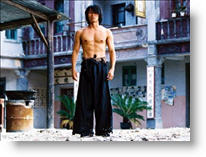
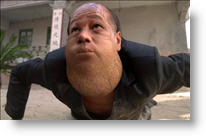
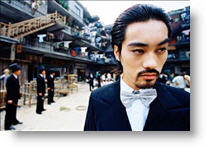
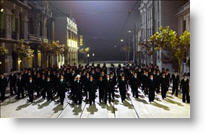
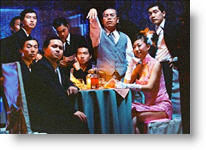

If one is aware at the beginning that this is strong satire and tongue-in-cheek, then the disturbing elements are easier to take. My three teenagers, one girl, two boys, enjoyed this film immensely. I saw it without hearing much about the plot first and I’m very glad it was so, because the surprises in this movie are great. One knows the way it will all work out in the end, or at least hopes it will work out, but is continually surprised at the twists that are taken to get to the end. Oh joy! To be surprised pleasantly at a movie.
My Ratings: Average/5